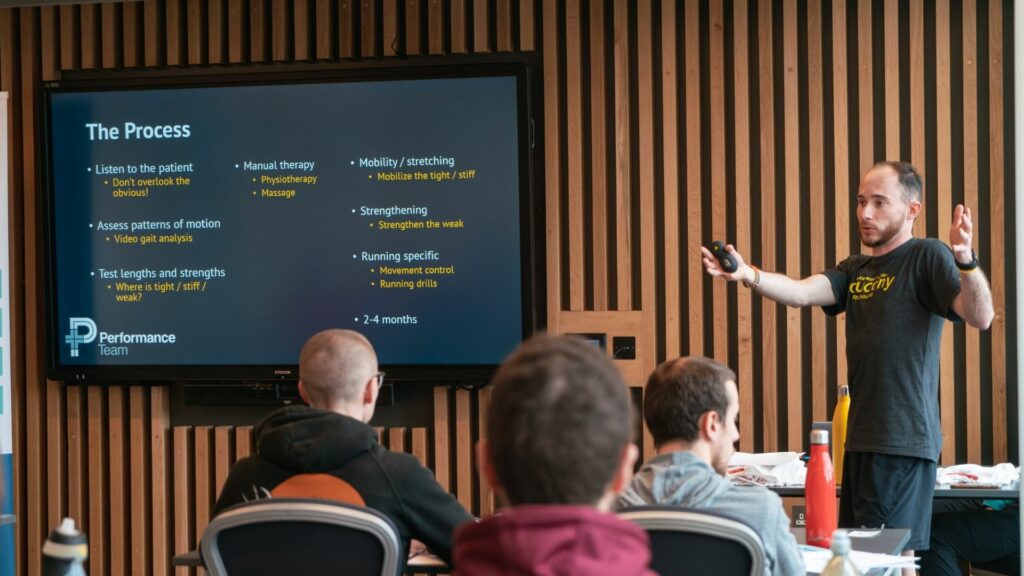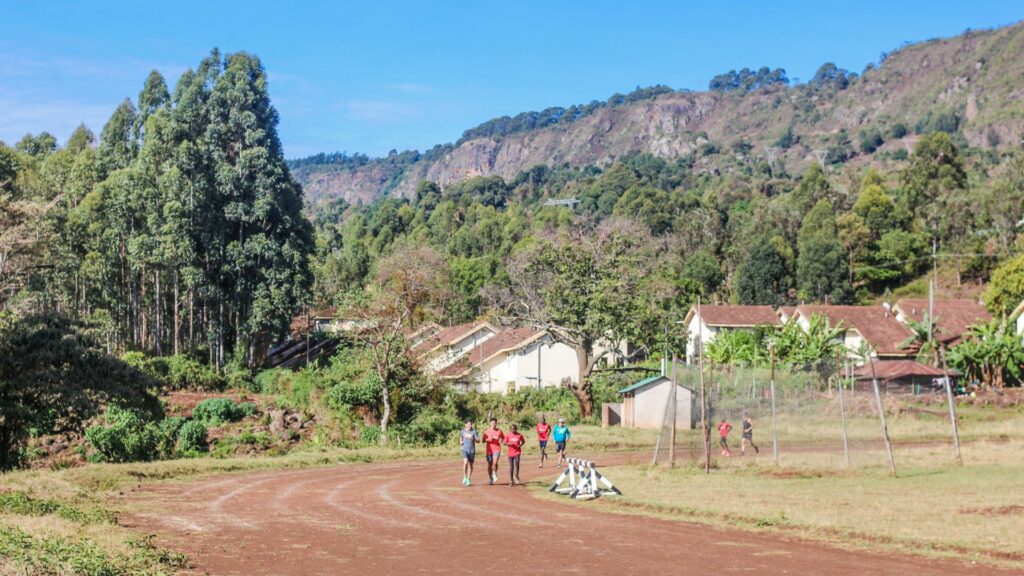
In this article, Running Specialist Physio Matt Bergin from Performance Team discusses common training errors which can lead to injuries in runners.
Matt is a sub 14minute 5k runner and physiotherapist specialising in the treatment and ongoing care of distance runners at the elite and club level. He’s the perfect person to help us understand why runners get problems and how we can attempt to mitigate them.
This article is part 2 of Matt’s series on injuries in runners – you can find part one here.
Why do runners get injured?
Training Errors
Runners typically get injured in one of two ways:
- Biomechanical issues such as muscular weakness, joint stiffness, or poor movement control that, over time, cause poor patterns of movement and overload structures of the musculoskeletal system and cause eventual injury1
- Training error2 – sudden increases in running volume or intensity or the sudden addition of a new type of training, such as track running, or hill sprints.
But why do these cause injury…
It’s a fine balancing act. The structures in our musculoskeletal system, especially tendons and bones, are very sensitive to load. Both structures require controlled and gradual exposure to load to strengthen and adapt, but too much of it and too much over a short period will often lead to overload and inevitable injury.
There will rarely be a sudden moment of injury with these issues either. With tendons, it will often start as a vague tightness or stiffness that will ease with running. But over a period of weeks, if the early warning signs are ignored and don’t modify your training, symptoms will likely worsen. That initial stiffness might not ease, or you might be left hobbling about post-run, or wake up the following morning with the same stiffness and soreness you experienced at the beginning of yesterday’s run.
Stuck in that cycle of injury?
Far too often someone’s aerobic capacity, i.e., their cardiovascular fitness, will exceed their structural capacity – the ability of their bones, tendons, and joints to tolerate the loads placed upon them, especially when new to running or returning from an extended period out. Yes, you might be capable of stepping outside and running 10km as your first run post-injury, but your Achilles tendon that you’ve been rehabbing for the past few weeks will unlikely be robust enough to tolerate that level of stress immediately and as a result, you quickly start to feel that same Achilles pain that you did six weeks previous.
To put things into perspective, if a runner on average takes around 180 steps per minute and they go out for a 20-minute run that equals 3600 steps (1800 per leg). If the following day they increase this to 30 minutes of running, it will equate to that runner taking roughly 5400 steps (2700 per leg) – an increase of 1800 steps over the duration of the run, an increase of over 60%.
Now consider that the Achilles tendon, when running experiences loads of up to 6-8x of body weight3. That increase from 20-30 minutes seems quite a lot now doesn’t it…
Variation is Key
Typically, people that are new to running do not vary their training, they simply go for 2-3 easy or steady runs a week. When you are first getting into running this is not a bad thing. However, when progressing from more than a couch to 5k type program you may quickly start to pick up aches, pains, and niggles from running the same routes, at the same pace, and in the same shoes.
Our musculoskeletal system like varying loads. Not dramatic, sudden changes in load, but varying loads. Whether that be rotating a few pairs of running shoes that offer different types of support, running on different terrains, or performing different types of training, the body likes variation.
But these must be incorporated gradually over time.
Suddenly changing from a shoe with maximal support to a shoe with minimal support will almost certainly lead to an overuse injury.
Similarly, if you jump from running 2-3 easy runs on flat paths to suddenly doing 3 runs a week on hilly trails you will likely develop overuse injuries.
When running slower you will spend greater time in contact with the ground and place more stress through the knees and thigh muscles, whereas when running quicker you will start to place greater stress through the structures of the foot, ankle, and calf. Therefore, suddenly going from running 2-3 easy runs a week to suddenly running 2-3 hard efforts a week will likely overload certain areas of the body and again put your body at risk of developing overuse injuries.
When it comes to avoiding these kinds of errors one of the best things you can do is get yourself an experienced running coach. Someone who will plan your weekly program, and ensure you are gradually progressing the volume as well as the intensity. Someone that will nag you about doing your exercises and alter the training regime should any aches, pains or niggles develop and point you in the direction should injury occur.
References
- Lee, K.K., Ling, S.K. and Yung, P.S., 2019. Controlled trial to compare the Achilles tendon load during running in flatfeet participants using a customized arch support orthoses vs an orthotic heel lift. BMC musculoskeletal disorders, 20(1), pp.1-12.
- Renström, A.F., 1993. Mechanism, diagnosis, and treatment of running injuries. Instructional course lectures, 42, pp.225-234.
- Neal BS, Lack SD, Lankhorst NE, Raye A, Morrissey D, van Middelkoop M. Risk factors for patellofemoral pain: a systematic review and meta-analysis. Br J Sports Med. 2019;53(5):270-281.
About the author:
Matt Bergin

Matt is a Sports Physiotherapist at Witty Pask & Buckingham and Performance Team, specialising in the treatment and physical management of endurance runners. He works alongside, and has been extensively trained by world-class physiotherapist Mark Buckingham and is a highly sought-after physio in his own right amongst both club and elite runners across the UK. Matt has a 5km personal best of 13:47 (which he has run twice!) and finished 10th at the 2017 World University Games on one of his many international appearances for Ireland.
Matt will be joining us in Kenya in September for Marathon Camp where he will lead seminars and practical sessions on the physical preparation of marathon runners. Matt will educate runners on injury prevention and biomechanical interventions for faster and reduced injury risk running.
Running Trips provide training camps for runners of all levels in Kenya and the UK.
Kenya Experience
Combine a serious training camp with a cultural immersion into the world of Kenyan Running.
Enjoy the ultimate running holiday with Kenya Experience.
NEW FOR SEPTEMBER 2022 – Marathon Camp Kenya
Training Focus Camps
UK-based weekend Training Camps. World-Class Experts, Small Groups, High-Performance Venues.
Improve your running with Training Focus Camps.



Recent Comments